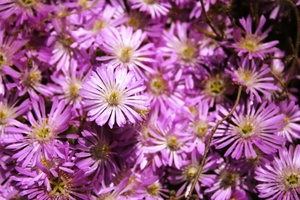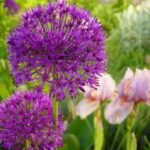Some grow as much as six feet tall having clusters of small, daisy-like flowers in pink, lavender, blue, purple, or white. Most are perennial plants, dying back to the ground in winter and reappearing in the spring. While these tall, relatively coarse plants add fall color to the fields, they are often considered too “weedy” for the average garden. However, improved varieties of perennial asters have been developed that are suitable for the home flower garden.
They are good companions with chrysanthemums since they are taller for background use, and can add a wide color range to the fall flower border. Hardy asters received much popularity in England where most of the work to develop improved varieties has been carried out. In England they are often called Michaelmas daisies, because they reach their peak bloom period about St. Michael’s Day, Sept. 29.
Most of the varieties that are available today are hybrids between the New England asters, New York asters, and some other species. In spite of their desirable fall color, hardy asters have not received wide use in the United States. One reason for this has been their tall growth. However, new varieties are much bushier and only two to three feet tall. They are useful in the middle of a flower border close to perennials, such as Oriental poppy, that die back in mid-summer. They can hang over this empty space as they expand.
A second reason they are not grown frequently is that they are subject to several leaf diseases. Most common of the leaf diseases are mildew and rust. While these do not seriously damage the plants, leaves can look unsightly. Therefore, their use as background plants is in a location where the base is often hidden by other plants. Some of the low, bushy varieties form mounds, which hide most of the foliage when in bloom.
The other disease problem is aster yellows, which causes deformation of the flowers and stunts growth. When this disease is evident, plants should be destroyed. Generally, however, hardy asters perform well in the average garden, and are particularly suitable where durable, low-maintenance perennial flowers are wanted. They are best suited to a sunny location and should be planted in April. While they like a rich soil, they are well adapted to a wide range of soil types and can tolerate poor soils, although growth will be less dense.
They like plenty of moisture, but will not tolerate wet locations. Since these plants are subject to leaf diseases, they should not be crowded, but planted where they get good air movement around the foliage. To keep the plants shorter and more heavily branched, it is helpful to pinch out the growing tips of each shoot in the late spring and again about a month later. Hardy asters may self-sow seeds freely, but since the desirable varieties are hybrids, these seedlings will not be true to type, and should be destroyed. Desirable varieties may be increased by dividing the crowns in the spring every two to three years. When replanting from a clump, select only the most vigorous sections.
http://en.wikipedia.org/wiki/Aster_(genus)




